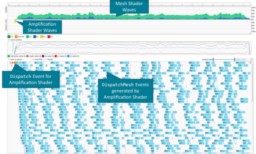- the article presents an overview of mesh shaders and amplification shaders
- shows the considerations and constraints on RDNA2/3 hardware
- showcases the tools available to profile the different stages and identify bottlenecks

- the article presents a detailed look at implementing a mesh shader based rendering pipeline
- each step is accompanied by performance numbers on Nvidia and AMD
- shader code samples are provided

- the author presents an alternative method to calculate the previous frame screen space position given a world space position
- this technique doesn’t rely on projection matrices

- the blog post introduces a new GPU-based debugging tool to make finding shader issues easier
- allows the detection of out-of-bounds access, resource-bound validation, NAN detection, concurrency validation, and more
- works with Vulkan and D3D12 on both AMD and Nvidia GPUs

- the video provides an overview and introduction to machine learning from a game development perspective
- explaining the standard terms, intuition, building an example network, and finally running the example network using D3D12
- the example code is provided

- the article presents a method to construct rhombic dodecahedral honeycomb elements from an integer grid
- shows an example of an SDF represented using the method
- presents how to generate the mesh surfaces
- additionally presents some ideas on what the method might be used for

- the article explains the packing rules for Constant buffers when used with D3D11/D3D12
- provides examples of different structures
- shows visually how the different members are packed into memory

- the article provides an overview of GPU sorting algorithms
- provides high-level comparisons between the techniques
- links to papers and implementations of the techniques are provided

Thanks to atyuwen for support of this series.
Would you like to see your name here too? Become a Patreon of this series.